By Leen Randell
Updated: Jul 04, 2024
10 Best Herbal Decoctions For Colds
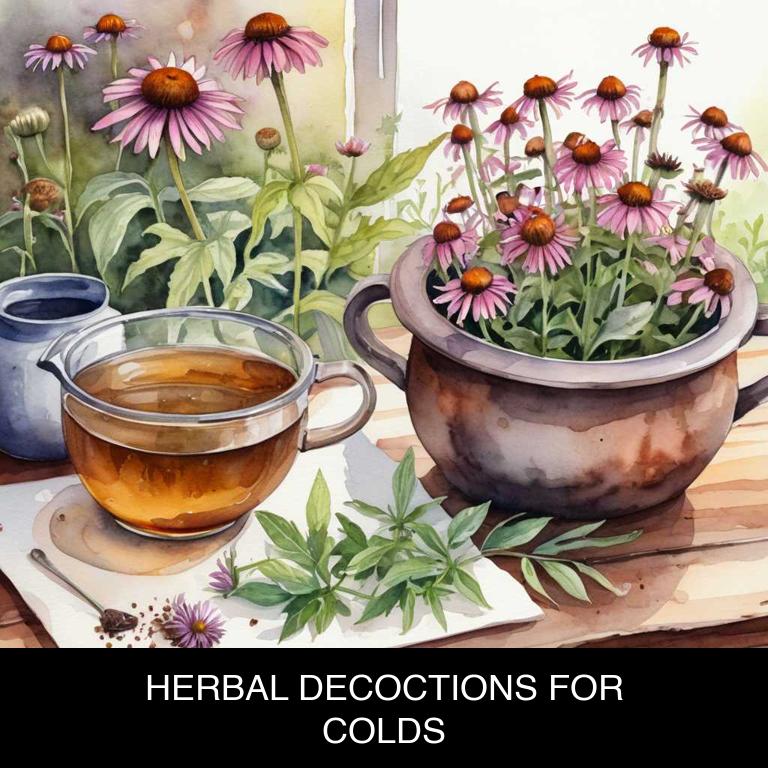
Herbal decoctions for colds are a natural way to alleviate symptoms associated with upper respiratory infections.
These decoctions are made by steeping herbs in hot water, releasing their medicinal properties and antioxidants. By drinking these herbal teas, individuals can help soothe a sore throat, relieve congestion, and reduce fever. For example, peppermint and eucalyptus decoctions can ease coughs and open up airways, while ginger and lemon balm decoctions can provide anti-inflammatory relief.
As a result, people can find natural relief from cold symptoms, improving their overall well-being and quality of life.
The following article describes in detail the most important decoctions for colds, including medicinal properties, parts of herbs to use, and recipes for preparations.
- 1. Echinacea purpurea
- 2. Andrographis paniculata
- 3. Echinacea angustifolia
- 4. Ginkgo biloba
- 5. Sambucus nigra
- 6. Thymus serpyllum
- 7. Echinacea pallida
- 8. Hydrastis canadensis
- 9. Glycyrrhiza glabra
- 10. Taraxacum officinale
- What is the best combination of herbal decoctions to use for colds?
- What ailments similar to colds are treated with herbal decoctions?
1. Echinacea purpurea
Purple coneflower decoctions helps with colds because they contain compounds like phenolic acids, terpenoids, and flavonoids that have potent anti-inflammatory and antimicrobial properties.
These compounds help to reduce congestion and relieve sinus pressure by soothing the mucous membranes in the respiratory tract. Additionally, purple coneflower's antiviral properties help to combat the underlying viral infection, reducing the severity of symptoms and shortening the duration of illness.
By promoting a healthy immune response, herbal decoctions can provide natural relief from cold-related discomforts.
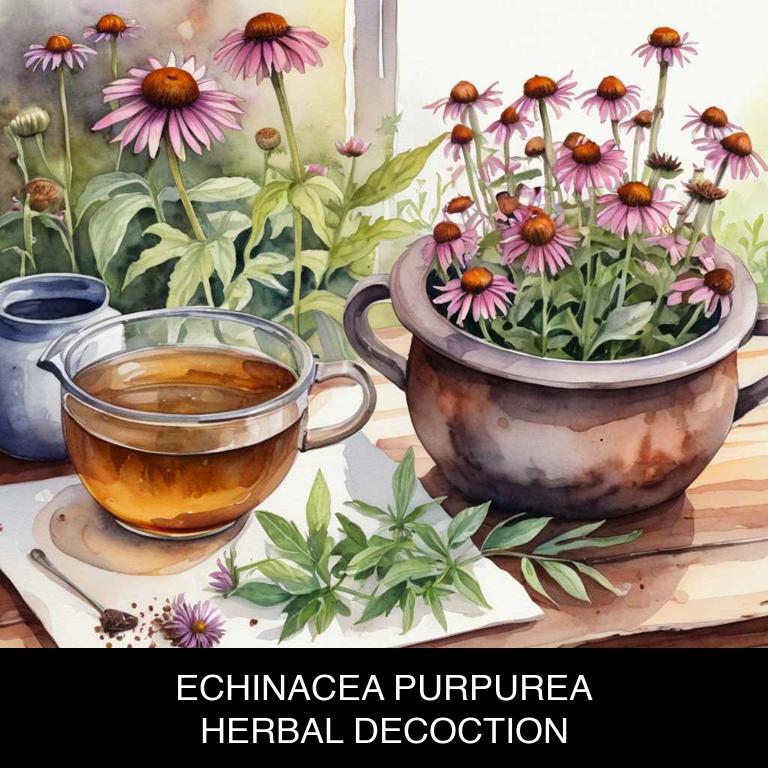
Medicinal Constituents
The list below shows the primary medicinal constituents in Echinacea purpurea decoctions that help with colds.
- Ige-inhibiting polysaccharides: These compounds help with colds by inhibiting the production of IgE antibodies, which contribute to allergic reactions and inflammation that often accompany colds.
- Cichoric acid: This phenolic compound has anti-inflammatory properties, which help reduce swelling and inflammation in the respiratory tract, alleviating cold symptoms such as congestion and sore throat.
- Alkylamides: These terpenes have immunomodulatory effects, which help stimulate the immune system to fight off invading pathogens and reduce the severity of cold symptoms such as coughing and fatigue.
Parts Used
The list below shows the primary parts of purple coneflower used to make decoctions for colds.
- Roots: They are the primary source of echinacoside and alkylamides, which contribute to Echinacea's medicinal properties.
- Leaves: They contain a higher concentration of flavonoids and phenolic acids, which provide antioxidant and anti-inflammatory benefits.
- Flowers: They are rich in polysaccharides and glycoproteins, which stimulate the immune system and support the body's natural defenses against infections.
Quick Recipe
The following recipe gives a procedure to make a basic purple coneflower for colds.
- Harvest fresh or dried flowers and leaves of the medicinal plant from mature stems in late summer.
- Rinse the harvested plant material with filtered water to remove any dirt or debris.
- Combine one to two teaspoons of the plant material with one cup of boiling water in a heat-resistant container.
- Steep the mixture for 5 to 10 minutes to allow the active compounds to infuse into the water.
- Strain the decoction through a fine-mesh sieve or cheesecloth into a clean container to remove solids.
2. Andrographis paniculata
King of bitters decoctions helps with colds because its unique blend of herbs, such as goldenseal and echinacea, stimulates the immune system to fight off infection.
The decoction's antimicrobial properties also help to reduce congestion and inflammation in the throat and sinuses, making it easier to breathe and alleviating symptoms like coughing and sneezing. Additionally, its anti-inflammatory effects can help to soothe a sore throat and reduce fever.
By promoting a healthy immune response and reducing symptoms, King of bitters decoctions provides effective relief from cold and flu symptoms.
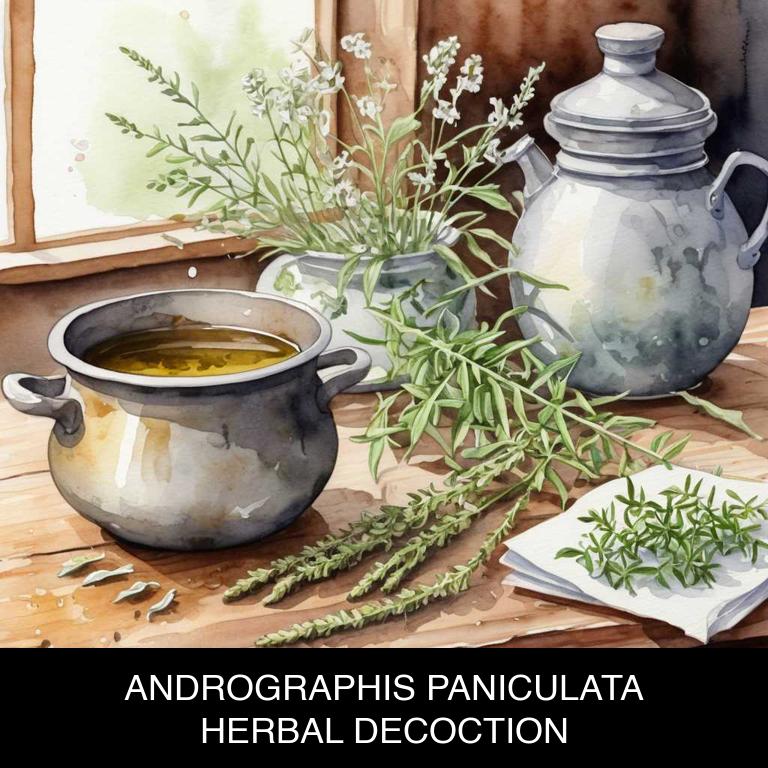
Medicinal Constituents
The list below shows the primary medicinal constituents in Andrographis paniculata decoctions that help with colds.
- Andrographolide: A sesquiterpene lactone that helps with colds by inhibiting the replication of the influenza virus and reducing inflammation in the respiratory tract.
- Dihydrodehydroandrographolide: A sesquiterpene lactone that exhibits anti-inflammatory and immunomodulatory activities, helping to alleviate symptoms of colds such as cough, sore throat, and congestion.
- 6-hydroxy-3-: A sesquiterpene lactone that has been shown to have anti-inflammatory and antioxidant properties, helping to protect against oxidative stress and inflammation in the respiratory tract during colds.
Parts Used
The list below shows the primary parts of king of bitters used to make decoctions for colds.
- Leaves: Used due to their high concentration of andrographolide, a compound believed to have immunomodulatory and anti-inflammatory effects.
- Roots: Utilized for their andrographolide content, which may help alleviate cold symptoms.
- Stems: Employed for their andrographolide and other bioactive compounds, which may aid in reducing inflammation and modulating the immune system.
Quick Recipe
The following recipe gives a procedure to make a basic king of bitters for colds.
- Harvest 50g of dried andrographis paniculata leaves and flowers from a reputable supplier or grow your own.
- Rinse the dried herb with 100ml of water to remove any impurities or debris.
- Steep 5g of the dried herb in 100ml of boiling water for 3 to 5 minutes.
- Strain the decoction using a cheesecloth or fine-mesh sieve into a clean container.
- Allow the decoction to cool to room temperature before consuming 20ml as needed.
3. Echinacea angustifolia
Kansas coneflower decoctions helps with colds because they contain potent bioactive compounds such as triterpenoid saponins, which exhibit anti-inflammatory and immunomodulatory properties.
These compounds work to soothe a sore throat, reduce congestion, and alleviate respiratory issues associated with the common cold.
Additionally, Kansas coneflower's antiviral activity helps to combat viral infections that cause cold symptoms, reducing the severity and duration of the illness.
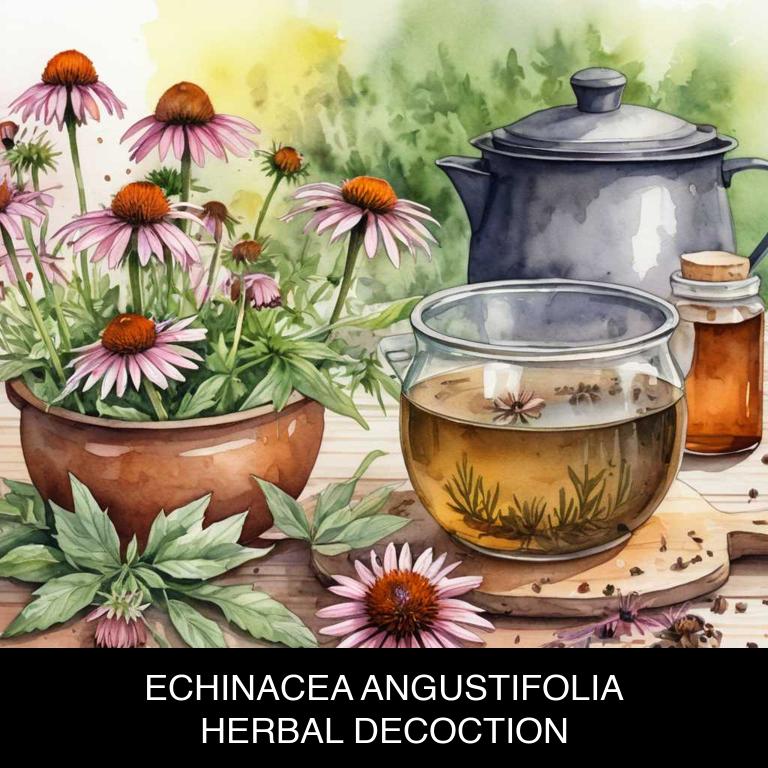
Medicinal Constituents
The list below shows the primary medicinal constituents in Echinacea angustifolia decoctions that help with colds.
- Alkylamides: These compounds have immunomodulatory effects, enhancing the body's natural defense mechanisms to fight off infections and reduce the severity of cold symptoms.
- Triterpene glycosides: Specifically, compounds like 11-hydroxy-11, 18-dihydroechinacin have shown anti-inflammatory properties, which can help alleviate the discomfort and pain associated with colds.
- Cichoric acid: This caffeic acid derivative has antioxidant and anti-inflammatory properties, helping to reduce oxidative stress and inflammation in the body, which can contribute to the development and severity of colds.
Parts Used
The list below shows the primary parts of kansas coneflower used to make decoctions for colds.
- Roots: The roots are the primary part used to make decoctions due to their high concentration of alkaloids, particularly echinacoside and caftaric acid, which have anti-inflammatory and immune-boosting properties.
- Leaves: The leaves are used to make decoctions that can be beneficial in treating colds due to their content of flavonoids and phenolic acids, which have antioxidant and anti-inflammatory properties.
- Stems: The stems are used to make decoctions that can aid in treating colds due to their content of phenolic acids and flavonoids, which have anti-inflammatory and antioxidant properties.
Quick Recipe
The following recipe gives a procedure to make a basic kansas coneflower for colds.
- Gather 2-4 grams of dried roots of echinacea angustifolia and store them in airtight containers.
- Combine the dried roots with 1 liter of boiling water in a large glass container.
- Steep the mixture for 5-10 minutes or up to 30 minutes for a stronger decoction.
- Strain the decoction through a cheesecloth or a fine-mesh sieve into a separate container.
- Drink the decoction 2-3 times a day, 1-2 cups at a time, as needed.
4. Ginkgo biloba
Maidenhair tree decoctions helps with colds because it contains compounds that have potent antiviral properties.
The decoction's active ingredients, such as flavonoids and terpenes, work to reduce the severity of cold symptoms by inhibiting the replication of viruses within the body. Additionally, the decoction's expectorant properties help to loosen mucus and promote its clearance from the respiratory tract, relieving congestion and coughing.
By targeting multiple aspects of the cold, maidenhair tree decoctions can provide effective relief and support during the recovery process.
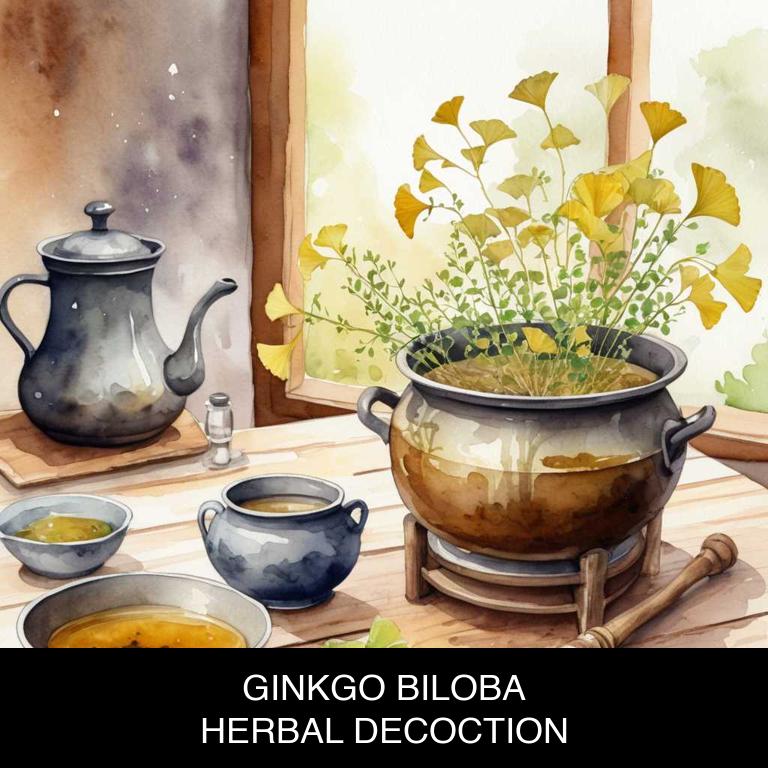
Medicinal Constituents
The list below shows the primary medicinal constituents in Ginkgo biloba decoctions that help with colds.
- Flavonoids: These polyphenolic compounds have antioxidant and anti-inflammatory properties, which help in reducing the severity of cold symptoms by neutralizing free radicals and preventing oxidative stress.
- Bilobalide: This sesquiterpenoid has neuroprotective and anti-inflammatory effects, which may help in alleviating symptoms of colds such as headaches and sore throats by reducing inflammation and promoting neural recovery.
- Quercetin: This flavonoid has potent anti-inflammatory and antioxidant properties, which may help in reducing the severity of cold symptoms by inhibiting the production of pro-inflammatory cytokines and enzymes that contribute to cold-related inflammation.
Parts Used
The list below shows the primary parts of maidenhair tree used to make decoctions for colds.
- Leaves: The leaves are the most commonly used part due to their high flavonoid and terpene content, which helps to relieve respiratory issues associated with colds.
- Seeds: Ginkgo seeds are also used due to their rich content of ginkgolides, which have anti-inflammatory properties that can help alleviate cold symptoms.
- Roots: The roots of Ginkgo biloba contain a higher concentration of ginsenosides, which can aid in reducing inflammation and improving respiratory function during a cold.
Quick Recipe
The following recipe gives a procedure to make a basic maidenhair tree for colds.
- Harvest 2-3 pounds of ginkgo biloba leaves from mature trees in late summer or early fall.
- Dry the leaves in a warm place at 60-70 degrees fahrenheit for 1-2 weeks.
- Chop 1 teaspoon of dried ginkgo biloba leaves into small pieces.
- Combine the chopped leaves with 2 cups of water in a saucepan and bring to a boil.
- Steep the mixture for 5-10 minutes then strain it before drinking the decoction.
5. Sambucus nigra
Elder decoctions helps with colds because they contain potent antiviral properties that directly target the underlying causes of respiratory infections.
The bioactive compounds present in elder flowers, such as flavonoids and phenolic acids, have been shown to inhibit viral replication and reduce inflammation in the lungs.
Additionally, elder decoctions possess expectorant properties, helping to loosen and clear mucus from the airways, making it easier to breathe and alleviating congestion symptoms associated with colds.
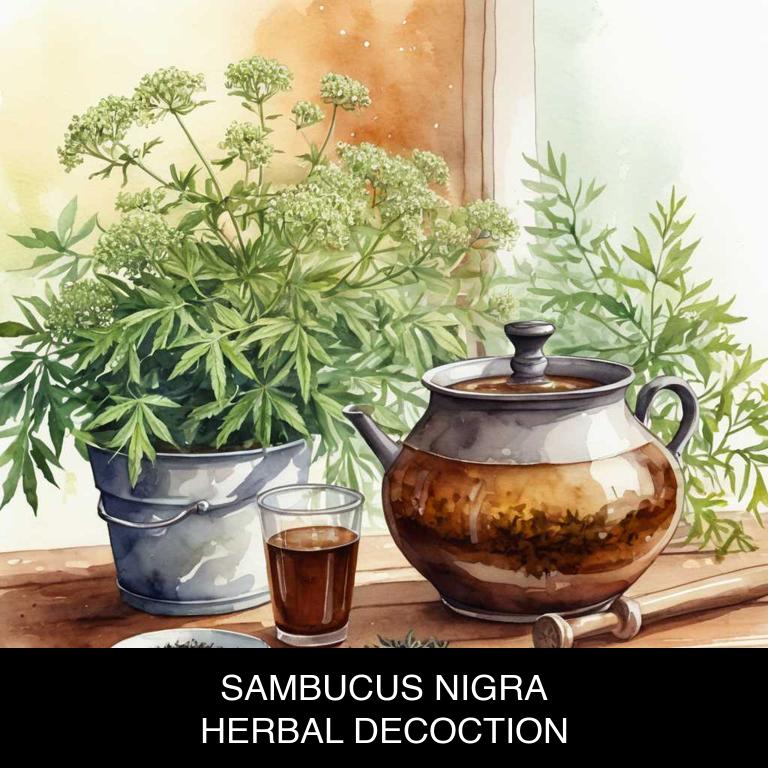
Medicinal Constituents
The list below shows the primary medicinal constituents in Sambucus nigra decoctions that help with colds.
- Vaccarin: Vaccarin is a flavonoid glycoside that helps to reduce the severity and duration of cold symptoms by inhibiting the release of pro-inflammatory mediators.
- Isovitexin: Isovitexin is a flavonoid glycoside that has anti-inflammatory and antiviral properties, which help to alleviate cold symptoms and prevent the replication of viral pathogens.
- Quercetin: Quercetin is a flavonoid that possesses anti-inflammatory and antioxidant properties, which help to reduce the severity of cold symptoms, such as congestion, sore throat, and cough, by inhibiting the release of histamine and other inflammatory mediators.
Parts Used
The list below shows the primary parts of elder used to make decoctions for colds.
- Flowers: The flowers of Sambucus nigra are used to make decoctions for colds because they contain high levels of antiviral and antimicrobial compounds that help alleviate symptoms.
- Roots: The roots of Sambucus nigra are used to make decoctions for colds because they have been traditionally used to treat respiratory issues and contain compounds that may help reduce inflammation.
- Leaves: The leaves of Sambucus nigra are used to make decoctions for colds because they are rich in flavonoids and other antioxidants that can help soothe and calm the respiratory system.
Quick Recipe
The following recipe gives a procedure to make a basic elder for colds.
- Harvest sambucus nigra flowers and leaves from a trusted source in the morning.
- Dry the harvested sambucus nigra flowers and leaves in a warm oven at 150.
- Measure out 20 grams of dried sambucus nigra flowers and leaves and add it.
- Simmer the mixture for 10 to 15 minutes over low heat to allow the active.
- Strain the decoction through a cheesecloth or a fine mesh sieve into a clean.
6. Thymus serpyllum
Creeping thyme decoctions helps with colds because of its natural antibacterial, anti-inflammatory, and decongestant properties.
The steam from the decoction can help loosen and clear mucus from the nasal passages, relieving congestion and sinus pressure. Additionally, the antimicrobial compounds in creeping thyme can help combat the underlying infection, reducing the severity and duration of cold symptoms such as coughing, sneezing, and fatigue.
This natural remedy can provide relief and promote a faster recovery when used consistently and in combination with other holistic treatments.
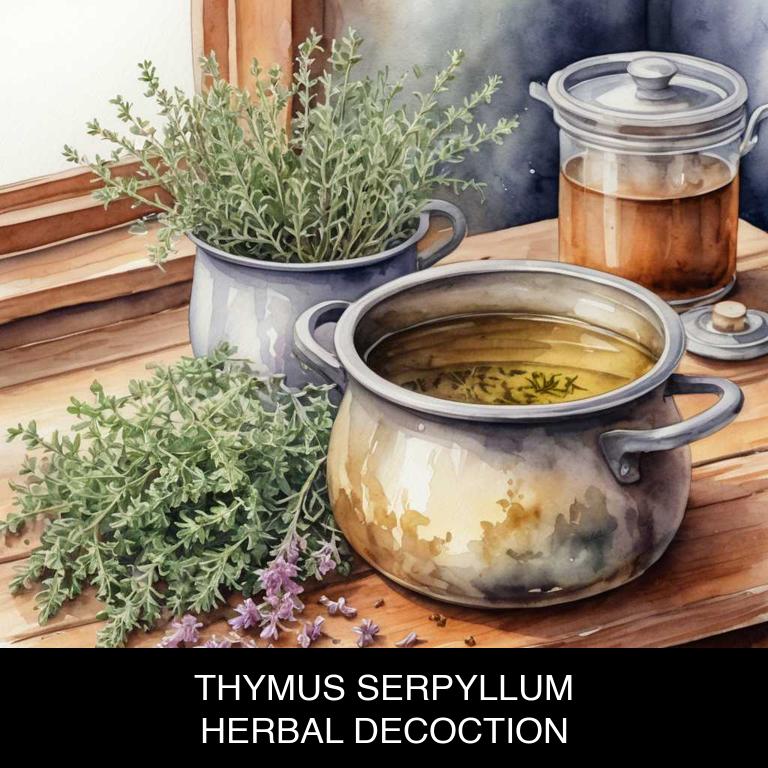
Medicinal Constituents
The list below shows the primary medicinal constituents in Thymus serpyllum decoctions that help with colds.
- Thymol: Thymol, a phenolic compound, has antimicrobial properties that help combat the underlying bacterial infections often associated with colds, thereby reducing symptoms and promoting recovery.
- Carvacrol: Carvacrol, another phenolic compound found in Thymus serpyllum, has anti-inflammatory properties that can help alleviate congestion and soothe a sore throat, making it easier to breathe and swallow.
- Rosmarinic acid: Rosmarinic acid, a phenolic acid, has antioxidant properties that can help reduce oxidative stress and inflammation in the body, which can contribute to the severity of cold symptoms and prolong recovery time.
Parts Used
The list below shows the primary parts of creeping thyme used to make decoctions for colds.
- Leaves: Used to make decoctions due to their antiseptic and expectorant properties, which help relieve congestion and coughs associated with colds.
- Flowers: Used to make decoctions due to their antiseptic and antimicrobial properties, which help soothe a sore throat and reduce inflammation.
- Roots: Used to make decoctions due to their expectorant properties, which help loosen and clear mucus from the respiratory tract, relieving congestion and coughs.
Quick Recipe
The following recipe gives a procedure to make a basic creeping thyme for colds.
- Harvest 1/2 cup of dried thymus serpyllum flowers and leaves for decoction.
- Combine the harvested herb with 2 cups of boiling water in a saucepan.
- Reduce the heat to low and simmer for 10-15 minutes or 5-10 minutes in a tea infuser.
- Strain the decoction using a cheesecloth or a fine-mesh sieve into a bowl.
- Discard the solids and store the decoction in the refrigerator for up to 24 hours.
7. Echinacea pallida
Pale coneflower decoctions helps with colds because it has been traditionally used to soothe sore throats, ease congestion, and reduce fever.
The plant's active compounds, such as echinacea and polyphenols, possess potent antimicrobial properties that help combat the underlying infection. Additionally, pale coneflower's anti-inflammatory properties can help alleviate sinus pressure and relieve chest tightness.
By drinking a warm decoction of pale coneflower, individuals can harness its natural healing powers to alleviate cold symptoms and promote a speedy recovery.
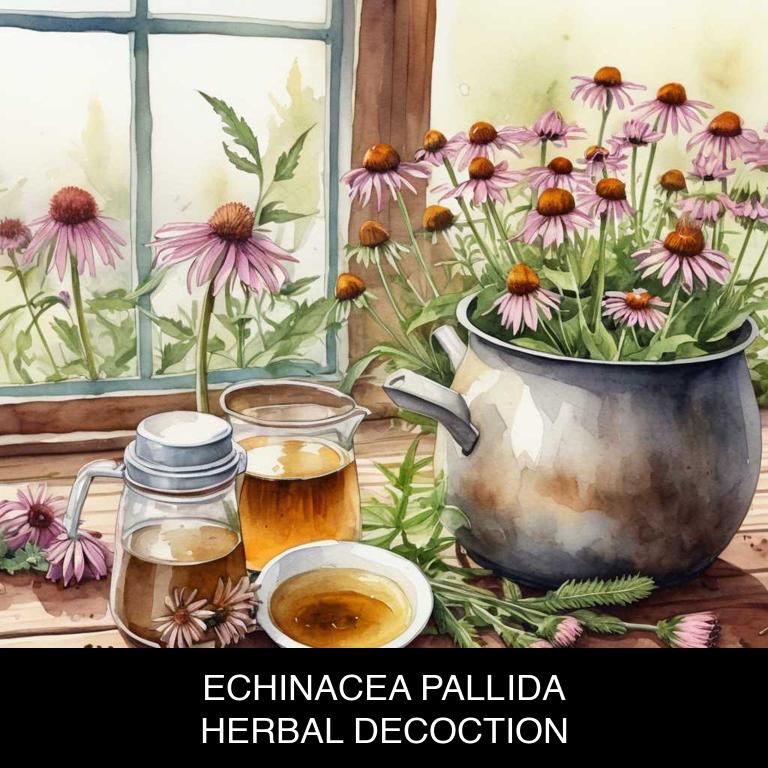
Medicinal Constituents
The list below shows the primary medicinal constituents in Echinacea pallida decoctions that help with colds.
- Iridoid glycosides: These compounds help modulate the immune system by stimulating the production of white blood cells, which aids in fighting off viral infections that cause the common cold.
- Flavonoids: Flavonoids present in Echinacea pallida decoctions exhibit antioxidant and anti-inflammatory properties, which help reduce the severity and duration of cold symptoms by protecting cells from oxidative damage and inflammation.
- Alkylamides: Alkylamides are known to exhibit immunomodulatory effects, enhancing the activity of natural killer cells and increasing the production of cytokines, which are essential for fighting off viral infections and reducing the severity of cold symptoms.
Parts Used
The list below shows the primary parts of pale coneflower used to make decoctions for colds.
- Roots: They are used due to their high concentration of bioactive compounds, which are believed to stimulate the immune system.
- Leaves: They are used for their anti-inflammatory and antiviral properties, which help to alleviate cold symptoms.
- Flowers: They are used for their immunomodulatory effects, which aid in reducing the severity and duration of colds.
Quick Recipe
The following recipe gives a procedure to make a basic pale coneflower for colds.
- Harvest echinacea pallida roots in the fall or spring when the plant is dormant to ensure quality.
- Clean and dry the roots thoroughly to prevent contamination and preserve their potency.
- Chop the dried roots into small pieces to increase their surface area for infusion.
- Combine 1-2 teaspoons of chopped echinacea pallida roots with 8 ounces of boiling water in a heat-resistant container.
- Steep the mixture for 5-10 minutes before straining it to create a decoction.
8. Hydrastis canadensis
Goldenseal decoctions helps with colds because it contains berberine, a natural compound that exhibits antiviral and anti-inflammatory properties.
Berberine has been shown to inhibit the replication of viruses that cause colds, reducing their ability to spread and multiply in the body. Additionally, goldenseal's anti-inflammatory properties can help alleviate congestion and reduce sinus pressure, making it easier to breathe and recover from a cold.
By drinking goldenseal decoctions regularly, individuals may experience relief from cold symptoms and support their immune system's natural defenses.
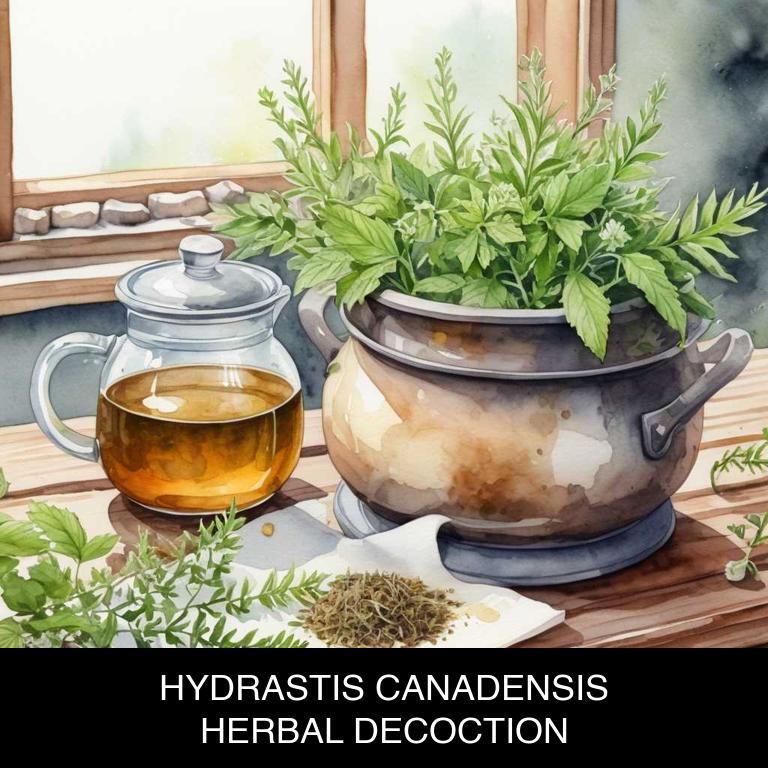
Medicinal Constituents
The list below shows the primary medicinal constituents in Hydrastis canadensis decoctions that help with colds.
- Volatile oils: These terpene-based compounds have anti-inflammatory properties, which can help reduce congestion and ease cold symptoms.
- Berberine: As a phenolic alkaloid, berberine has antimicrobial properties, which can help combat cold-causing pathogens and reduce the severity and duration of colds.
- Hydrastine: This phenolic alkaloid has astringent and antimicrobial properties, which can help reduce mucus production, ease congestion, and prevent the spread of infection.
Parts Used
The list below shows the primary parts of goldenseal used to make decoctions for colds.
- Roots: The root is the most commonly used part, as it contains the highest concentration of berberine, a compound with antimicrobial and anti-inflammatory properties that helps alleviate cold symptoms.
- Leaves: The leaves are also used in decoctions, as they contain berberine and other alkaloids that provide relief from cold and flu symptoms, including congestion and cough.
- Stems: The stems of Hydrastis canadensis are sometimes used in decoctions for their antiseptic and anti-inflammatory properties, which can help reduce the severity of cold symptoms.
Quick Recipe
The following recipe gives a procedure to make a basic goldenseal for colds.
- Harvest 1-2 ounces of dried root from mature plants in the fall season for optimal potency.
- Grind 1-2 teaspoons of dried root into a fine powder using a mortar and pestle.
- Combine the ground root powder with 1 quart of boiling water in a heat-resistant container.
- Reduce heat to a simmer and let the mixture steep for 30-45 minutes or 3-5 minutes per ounce of root.
- Strain the decoction through a cheesecloth or fine-mesh sieve into a clean container.
9. Glycyrrhiza glabra
Licorice decoctions helps with colds because it contains compounds that have natural anti-inflammatory and antiviral properties.
The glycyrrhizin present in licorice root has been shown to reduce inflammation in the throat and chest, alleviating symptoms of a cough and congestion.
Additionally, its expectorant properties help to loosen and clear mucus from the respiratory tract, making it easier to breathe and recover from the cold.

Medicinal Constituents
The list below shows the primary medicinal constituents in Glycyrrhiza glabra decoctions that help with colds.
- Glycyrrhizin: This triterpenoid saponin has anti-inflammatory and expectorant properties, helping to reduce congestion and alleviate coughs associated with colds.
- Flavonoids: These phenolic compounds possess antioxidant and anti-inflammatory properties, which can help combat the underlying oxidative stress and inflammation caused by viral infections, thus aiding in the recovery from colds.
- Liquiritin: This phenolic compound has been shown to have expectorant and anti-inflammatory properties, which can help loosen and clear mucus, reducing congestion and coughs associated with colds.
Parts Used
The list below shows the primary parts of licorice used to make decoctions for colds.
- Roots: Roots are the primary part used to make decoctions for colds due to their high content of glycyrrhizin, a compound with anti-inflammatory properties.
- Stems: Stems are used in decoctions for colds as they contain flavonoids and other compounds that help to soothe and calm the respiratory system.
- Barks: Barks are used to make decoctions for colds as they contain phenolic compounds that have antimicrobial and anti-inflammatory properties, helping to combat infection and reduce inflammation.
Quick Recipe
The following recipe gives a procedure to make a basic licorice for colds.
- Harvest 250g of glycyrrhiza glabra roots in late summer or early fall when the plant is in full maturity.
- Clean the roots by gently scrubbing them with a soft brush and then rinse with cold water.
- Cut the roots into smaller pieces and then weigh out 25g for every 250ml of water.
- Combine the cut roots with water in a saucepan and bring to a boil then reduce heat to low.
- Simmer for 10 to 30 minutes then strain the decoction through a cheesecloth into a clean container.
10. Taraxacum officinale
Dandelion decoctions helps with colds because of its natural expectorant properties that help to loosen and clear mucus from the chest and nasal passages.
The decoction's anti-inflammatory compounds also reduce congestion and soothe a sore throat, making it easier to breathe and speak. Additionally, dandelion's antiviral properties help to combat the underlying viral infection, reducing the severity and duration of cold symptoms.
By promoting healthy digestion and reducing inflammation, dandelion decoctions provide a natural and effective way to alleviate cold-related discomforts.

Medicinal Constituents
The list below shows the primary medicinal constituents in Taraxacum officinale decoctions that help with colds.
- Flavonoids: These help with colds by exhibiting anti-inflammatory properties, which can reduce the severity of symptoms such as congestion and sore throats.
- Saponins: These help with colds by displaying immunomodulatory effects, which can enhance the body's natural defense mechanisms against viral infections.
- Polysaccharides: These help with colds by stimulating the production of interferon, a protein that plays a crucial role in the immune system's response to viral infections.
Parts Used
The list below shows the primary parts of dandelion used to make decoctions for colds.
- Leaves: Used for their anti-inflammatory and diuretic properties to help alleviate cold symptoms.
- Roots: Employed for their bitter compounds, which aid in stimulating the immune system and reducing congestion.
- Flowers: Utilized for their antiviral and antimicrobial properties to combat viral infections and promote recovery from colds.
Quick Recipe
The following recipe gives a procedure to make a basic dandelion for colds.
- Harvest approximately 2 cups of the fresh above-ground parts of taraxacum officinale in the early morning.
- Rinse the harvested taraxacum officinale thoroughly with cold water to remove any dirt or debris.
- Chop the cleaned taraxacum officinale into small pieces and combine them with 4 cups of water in a saucepan.
- Bring the mixture to a boil then reduce heat and simmer for 10 to 15 minutes.
- Strain the decoction through a cheesecloth into a clean container discarding the solids.
What is the best combination of herbal decoctions to use for colds?
The best combination of herbal decoctions that help with colds is a blend of Echinacea, Ginger, and Eucalyptus.
Echinacea is known for its immune-boosting properties, while Ginger helps to alleviate congestion and soothe a sore throat. Eucalyptus adds its decongestant properties, easing breathing and relieving sinus pressure. Drinking a warm decoction of these herbs can help to reduce the severity and duration of cold symptoms, promoting a faster recovery and alleviating discomfort.
This combination can be consumed as a tea or added to a warm bath for added benefits.
What ailments similar to colds are treated with herbal decoctions?
Ailments similar to colds/decoctions.html">colds/decoctions.html">colds that are treated with herbal decoctions are bronchitis, coughs, and upper respiratory tract infections.
Herbal decoctions can help soothe a sore throat, reduce congestion, and ease coughing. Decoctions made from herbs such as thyme, ginger, and slippery elm have anti-inflammatory properties, while those containing peppermint and eucalyptus may help clear mucus and relieve chest congestion.
These herbal remedies can be used to create teas, tinctures, or syrups for effective treatment of these conditions.